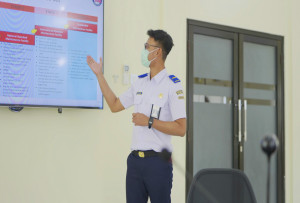Risk Management, Why is it Important for Public Sector Institutions?

By Yosep Yogo Widhiyatmoko
Purwodadi – The Government of the Republic of Indonesia continues to improve to face the era of globalization. One of them is that the state is experiencing a change towards a better direction in terms of the management of public institutions within it, both central and regional government institutions.
The management of public institutions in question is in the content of good governance, as is the case with good corporate governance when it is associated with company management.
Good governance consists of various aspects of management, one of which is risk management which complements the governance regulations in the Republic of Indonesia.
It should be noted that initially good governance was introduced by donor agencies or foreign lenders such as the World Bank, Asian Development Bank, IMF and other lending institutions originating from developed countries. Good Governance is used as an aspect of consideration by donor agencies in providing loans and grants.
The concept of good governance in Indonesia began to emerge after the reform era began, which was motivated by problems left by the New Order government. Such as a government that is centered on the president, high state institutions that are not running well, and a lack of public participation in government.
During the reform era, the executive and legislative bodies succeeded in formulating three laws which later changed the system of government in Indonesia.
Law Number 32 of 2004 concerning granting greater authority to regional governments, both districts and cities, to manage governance and development. This law plays an important role in changing development policies and plans in the regions so that they are more in line with the conditions and circumstances of the people.
Law Number 28 of 2004 concerning granting greater authority to regional governments to manage and allocate funds in carrying out development.
Law Number 28 of 1999 concerning implementation in the field of development and implementation of government at the central and regional levels. Law Number 28 of 1999 is what then becomes the initial basis for implementing good governance as the basis for administering government.
The three laws above are the main foundation for implementing the concept of good governance in administering government in Indonesia. The Indonesian government will continue to develop regulations in the field of good governance in the future. This is marked by the presence of the term performance accountability in Government Regulation Number 8 of 2006 concerning Financial Reporting and Performance of Government Agencies, then the term good governance appears in Government Regulation Number 60 of 2008 concerning Government Internal Control Systems.
Then in 2014 Law Number 23 of 2014 concerning Regional Government appeared with several changes in the coming year, and Law Number 30 of 2014 concerning Government Administration, after previously in the same year the government had issued Government Regulation Number 29 of 2014 concerning the Performance Accountability System of Government Agencies .
From the legal basis above, the term risk management appears explicitly in PP Number 60 of 2008. The PP states that the Internal Control System is an integral process of actions and activities carried out continuously by leaders and all employees with the aim of providing adequate assurance for achieving organizational goals through effective and efficient activities, reliability of financial reporting, safeguarding state assets, and compliance with laws and regulations.
Risk Management is one of the elements in the Government's Internal Control System, which includes control environment, risk assessment, control activities, information and communication, as well as internal control monitoring.
Looking at the definition and elements of the Internal Control System, risk management can then be translated as one part of an integral process that must be carried out to achieve the goals of government organizations.
The role of risk management itself is in Government Regulation Number 60 of 2008 article 11 letter b, which states that the role of the government's internal supervisory apparatus is required (one of them) namely providing early warning and increasing the effectiveness of risk management in carrying out the duties and functions of Government Agencies.
So it is clear that the function to provide early warning must be carried out, and the tool that can be used is risk management.
Referring to the Paris Review magazine 2020/No.12 Edition, a media publication published by BPKP Yogyakarta Province. In this edition BPKP specifically reviews risk management, complete with theory and portraits of implementation in the field.
On page 13 of the magazine, it is stated that the oldest record of risk management practices dates back to 2100 BC in the Hammurabi Charter. The charter stipulates that the ship owner can borrow money to buy cargo, but if in transit his ship sinks or is lost, he does not need to repay the loan. This phase is known as the first era of risk management, characterized by companies that only look at non-entrepreneurial risks, such as security risks.
The 1970s and 1980s have been called the second era of risk management. Insurance companies began to try to encourage employers to really keep the insured goods. During this period, the concept of quality assurance was also born, which guaranteed that each product met its standard specifications. This concept was popularized by the British Standards Institution which launched the BS 5750 quality standard in 1979.
The third era of risk management began in 1995 with the publication of AS/NZS 4360:1995 by Standards Australia of the World's Risk Management Standard. Until now, risk management has developed with the addition of two major references that have become international standards for implementing risk management, namely COSO Enterprise Risk Management–Integrated Framework 2004 which combines a risk management approach with internal control, and ISO 31000: 2009 Risk Management – Principles and Guidelines.
In Indonesia, risk management was first implemented in 2008 at the Ministry of Finance in response to the mandate of Government Regulation no. 60 of 2008 concerning the Government Internal Control System (SPIP), which stipulates that risk management must be implemented in all government agencies.
Risk management according to PP 60/2008 and its development takes the essence of three risk management frameworks from the three major schools of risk management international standards namely AS/NZS 4360:2004, COSO ERM-2004 and ISO 31000:2018.
The three risk management models in principle provide an overview of a determination of a strategy designed to identify potential conditions/events that may affect the achievement of organizational goals and manage risks that may occur, to provide adequate assurance that achievement of organizational goals can be realized with an emphasis on risk culture, system , and risk management processes.
When translated, by using risk management, an organization in the context of the public sector will be able to see things that might happen, and those that are categorized as having the potential to affect the organization's performance.
As part of the organization of the Directorate General of Railways of the Ministry of Transportation, the Railway Care Center also plays a role as part of the motor in efforts to implement risk management in the internal environment of the organization. Risk management management activities are guided by the Decree of the Director General of Railways Number: HK.209/3/19/DJKA/2022 concerning Technical Guidelines for Implementation of Risk Management within the Directorate General of Railways. These efforts will later become an integral part of the risk management implementation framework for the Directorate General of Railways. (yogo)






.jpg)



Komentar
LOGIN FOR COMMENT Sign in with Google